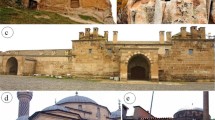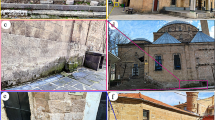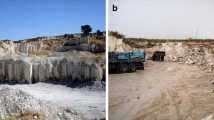Abstract
The present study included the effect of four salt types and their four different concentrations on the pore size distribution of Döğer tuff which was subjected to salt crystallization tests. For this purpose, laboratory studies were carried out in three stages. First, the main technical values and parameters were studied such as mineralogical–petrographic (polarizing microscope, XRD, and SEM), chemical (XRF), physico-mechanical, and pore size distribution properties. Second, salt crystallization tests were performed to examine the pore size distribution change. The salt concentrations were prepared as 2, 5, 10, and 14% for each salt solution. Last, the pore size distribution changes of Döğer tuff after the salt crystallization tests were investigated through the SEM and the mercury porosimeter method. Fresh Döğer tuff with 36.67% porosity exhibited a unimodal pore size distribution, with a pore size range of 0.01–5 µm. The experimental results corroborate the theoretical supposition that micropores smaller than 0.1 µm in diameter are a critical influence on salt crystallization damage. The size of the pores and total porosity in Döğer tuff increased in parallel with the increase in salt concentrations. The maximum pore increased because deterioration was 42.11% in 14% sodium sulfate solution. The 14% solutions of the potassium chloride, magnesium sulfate, and sodium chloride salts constituted porosity ranging from about 41.05, 38.77, and 38.77%, respectively. The test results indicated that salt types and concentrations play a very important role in both salt uptake and pore size distribution.




modified from MTA 2021)













Similar content being viewed by others
References
Agnew N, Maekawa S, Wei S (2010) Causes and mechanisms of deterioration and damage in Cave 85, Conservation of Ancient Sites on the Silk Road: Proceedings of the Second International Conference on the Conservation of Grotto Sites, Mogao Grottoes, Dunhuang, People‘s Republic of China, June 28-July 3, 2004, N. Agnew ed., Los Angeles: Getty Conservation Institute, 412–420
Alves C, Figueiredo C, Maurício A (2017) A critical discussion of salt weathering laboratory tests for assessment of petrological features susceptibility. Procedia Earth Planet Sci 17:324–327. https://doi.org/10.1016/j.proeps.2016.12.082
Angeli M, Bigas JP, Benavente D, Menendez B, Herbert R, David C (2007) Salt crystallization in pores: quantification and estimation of damage. Environ Geol 52:187–195. https://doi.org/10.1007/s00254-006-0474-z
Angeli M, Benavente D, Bigas JP, Menendez B, Hebert R, David C (2008) Modification of the porous network by salt crystallization in experimentally weathered sedimentary stones. Mater Struct 41:1091–1108. https://doi.org/10.1617/s11527-007-9308-z
Benavente D, Garcia del Cura MA, Garcia-Guinea J, Sanchez-Moral S, Ordonez S (2004a) Role of pore structure in salt crystallization in unsaturated porous stone. J Cryst Growth 260:532–544. https://doi.org/10.1016/j.jcrysgro.2003.09.004
Benavente D, Garcia Del Cura MA, Fort R, Ordonez S (2004b) Durability estimation of porous building stones from pore structure and strength. Eng Geol 74:113–127. https://doi.org/10.1016/j.enggeo.2004.03.005
Benavente D, Martinez-Martinez J, Cueto N, Garcia del Cura MA (2007) Salt weathering in dual-porosity building dolostones. Eng Geol 94:215–226. https://doi.org/10.1016/j.enggeo.2007.08.003
Charola AE (2000) Salts in the deterioration of porous materials: an overview. J Am Inst Conserv 39:327–343
Çelik MY, Tığlı R (2018) The investigation of the water repellent chemical influence on salt crystallization in high porous building stones. J Fac Eng Archit Gazi Univ 34(1):535–552. https://doi.org/10.17341/gazimmfd.416513
Çelik MY, Aygün A (2019) The effect of salt crystallization in porous building stones by sodium sulfates and sodium chlorides on degradation. Bull Eng Geol Environ 78(5):509–3529. https://doi.org/10.1007/s10064-018-1354-y
Çelik MY, Sert M (2020a) Accelerated ageing laboratory tests for the evaluation of the durability of hydrophobic treated and untreated andesite with respect to salt crystallization, freezing–thawing, and thermal shock. Bull Eng Geol Environ. https://doi.org/10.1007/s10064-020-01776-0
Çelik MY, Sert M (2020b) The role of different salt solutions and their concentration ratios in salt crystallization test on the durability of Döğer tuff (Afyonkarahisar-Turkey) used as building stones of cultural heritages. Bull Eng Geol Environ 79:5553–5568
Çelik MY, Sert M (2020c) An assessment of pore size distribution changes of the andesite (İscehisar, Turkey) used as building stone in relation to the six artificial accelerated aging factors. Geoheritage (2020) 12:71. https://doi.org/10.1007/s12371-020-00501-3
Deng T (2012) Stable and metastable phase equilibria in the salt-water systems, in: Advances in crystallization processes; Mastai Y, Ed.; InTech; ISBN: 978–953–51–0581–7
Derluyn H, Moonen P, Carmeliet J (2014) Deformation and damage due to drying-induced salt crystallization in porous limestone. J Mech Phys Solids 63(1):242–255. https://doi.org/10.1016/j.jmps.2013.09.005
Dinçer İ, Bostancı M (2019) Capillary water absorption characteristics of some Cappadocian ignimbrites and the role of capillarity on their deterioration. Environ Earth Sci 78:7. https://doi.org/10.1007/s12665-018-7993-2
Doehne E (2002) Salt weathering: a selective review, salt weathering: a selective review. Geol Soc Spec Pub 205(1):51–64
Everett DH (1961) The thermodynamics of frost damage to porous solids. Trans Faraday Soc 57:1541–1551. https://doi.org/10.1039/TF9615701541
Fakhimi A, Gharahbagh EA (2011) Discrete element analysis of the effect of pore size and pore distribution on the mechanical behavior of rock. Int J Rock Mech Min Sci 48(1):77–85. https://doi.org/10.1016/j.ijrmms.2010.08.007
Fitzner B, Snethlage R (1982) Ueber Zusammenhänge zwischen Salz Kristallisationsdruck und Porenradienverteilung. GP News-Letter 3:13–24
Flatt RJ (2002) Salt damage in porous materials: how high supersaturations are generated. J Cryst Growth 242:435–454. https://doi.org/10.1016/S0022-0248(02)01429-X
Flatt R, Aly Mohamed N, Caruso F, Derluyn H et al (2017) Predicting salt damage in practice: a theoretical insight into laboratory tests. RILEM Tech Lett 2:108–118. https://doi.org/10.21809/rilemtechlett.2017.41
Germinario L, Török Á (2020) Surface weathering of tuffs: compositional and microstructural changes in the building stones of the Medieval Castles of Hungary. Minerals 10(4):376. https://doi.org/10.3390/min10040376
Gonçalves TD, Brito V (2014) Alteration kinetics of natural stones due to sodium sulfate crystallization: can reality match experimental simulations? Environ Earth Sci 72:1789–1799. https://doi.org/10.1007/s12665-014-3085-0
Graue B, Siegesmund S, Middendorf B (2011) Quality assessment of replacement stones for the Cologne Cathedral: mineralogical and petrophysical requirements. Environ Earth Sci 63:1799–1822. https://doi.org/10.1007/s12665-011-1077-x
Guo G, Li L, Yang Z, Tao B, Qu Y, Zheng J (2005) Weathering mechanism of the Cretaceous argillaceous siltstone caverns, Longyou, China. Bull Eng Geol Environ 64:397–407
Gülyaz ME (2021) Deterioration and conservation of Cappadocian wall paintings. In: Aoki S. et al. (eds) Conservation and painting techniques of wall paintings on the Ancient Silk Road. Cultural Heritage Science. Springer, Singapore. https://doi.org/10.1007/978-981-33-4161-6_3
He X, Li J, Tao L, Zhang B, Fan Z, Su B (2019) Mechanisms of preservation damage: restoration materials affecting salt distribution and soil expansion in wall paintings of Dunhuang. Archaeol Anthropol Sci 11:5171–5179
Heidari M, Torabi-Kaveh M, Mohseni H (2017) Assessment of the effects of freeze–thaw and salt crystallization ageing tests on Anahita Temple stone, Kangavar. West of Iran Geotech Geol Eng 35:121–136. https://doi.org/10.1007/s10706-016-0090-y
IUPAC (1976) Manual of symbols and terminology for physicochemical quantities and units–appendix II. Definitions, terminology and symbols in colloid and surface chemistry. Part II: heterogeneous catalysis. Pure Appl Chem 46(1):71–90
Kashif M, Cao Y, Yuan G, Asif M et al (2019) Pore size distribution, their geometry and connectivity in deeply buried Paleogene Es1 sandstone reservoir, Nanpu Sag, East China. Pet Sci 16:981–1000. https://doi.org/10.1007/s12182-019-00375-3
Klopfer H (1985) Feuchte. In: Lutz P et al (eds) Lehrbuch der Bauphysik. Teubner, Stuttgart, pp 329–472
La Russa MF, Ruffolo SA, Rovella N, Belfiore CA, Pogliani P, Pelosi C, Andaloro M, Crisci GM (2014) Cappadocian ignimbrite cave churches: stone degradation and conservation strategies. Periodico Di Mineralogia 83(2):187–206
Li L, Yang Z, Yue ZQ, Pan W, Mu H (2005) Deformation and failure modes and reinforcement methods of the large ancient underground cavern group found in Longyou County. Chin J Rock Mech Eng 24(12):2018–2028
Li L, Yang ZF, Yue ZQ, Zhang LQ (2009) Engineering geological characteristics, failure modes and protective measures of Longyou rock caverns of 2000 years old. Tunn Undergr Space Technol 24:190–207. https://doi.org/10.1016/j.tust.2008.08.003
Luxán M, Gómez-Muñoz G, Barbero-Barrera MM, Román-López E (2014) Energy and constructive consequences of a bad practice. Skinned architectures. In M. López, A. Yáñez, S. Gomes da Costa, L. Avellá, coord. Proceedings of the International Conference on Energy Efficiency and Historic Buildings, Fundación de Casas Históricas y Singulares & Fundación Ars Civilis, Madrid
Metin S, Genç Ş, Bulut V (1987) The Geology of Afyon and its surroundings. (in Turkish, Unpublished), MTA Report No: 8103, Ankara
Molina E, Cultrone G, Sebastian E, Alonso FJ, Carrizo L, Gisbert J, Buj O (2011) The pore system of sedimentary rocks as a key factor in the durability of building materials. Eng Geol 118:110–121. https://doi.org/10.1016/j.enggeo.2011.01.008
Molina E, Cultrone G, Sebastián E, Alonso FJ (2013) Evaluation of stone durability using a combination of ultrasound, mechanical and accelerated aging tests. J Geophys Eng 10(3):035003. https://doi.org/10.1088/1742-2132/10/3/035003
MTA (2021) http://yerbilimleri.mta.gov.tr/anasayfa.aspx. Accessed 09 Mar 2021
Nabawy BS, Geraud Y, Rochette P, Bur N (2009) Pore-throat characterization in highly porous and permeable sandstone. AAPG Bull 93:719–739. https://doi.org/10.1306/03160908131
Nielsen CB (1991) Salts in porous building materials. Technical University of Denmark. Byg Rapport, No. TR-243
Ordonez S, Fort R, del Cura MG (1997) Pore size distribution and the durability of a porous limestone. Q J Eng Geol Hydrogeol 30:221–230. https://doi.org/10.1144/GSL.QJEG.1997.030.P3.04
Özşen H, Bozdağ A, İnce İ (2017) Effect of salt crystallization on weathering of pyroclastic rocks from Cappadocia. Turkey Arab J Geosci 10:258
Piqué F, Wong L, Boming S (2010) Methodology for the conservation of the wall paintings in Cave 85. Conservation of Ancient Sites on the Silk Road: Proceedings of the Second International Conference on the Conservation of Grotto Sites, Mogao Grottoes, Dunhuang, People‘s Republic of China, June 28-July 3, 2004, N. Agnew ed., Los Angeles: Getty Conservation Institute. 421–429
Přikryl R, Lokajíček T, Svobodová J, Weishauptová Z (2003) Experimental weathering of marlstone from Přední Kopanina (Czech Republic) – historical building stone of Prague. Build Environ 38(9–10):1163–1171. https://doi.org/10.1016/S0360-1323(03)00073-8
Přikryl R (2006) Assessment of rock geomechanical quality by quantitative rock fabric coefficients: limitations and possible source of misinterpretations. Eng Geol 87(3–4):149–162
Přikryl R, Török Á (2010) Natural stones for monuments: their availability for restoration and evaluation. In: Natural stone resources for historical monuments. Geological Society, London. Special Publications 333:1–9. https://doi.org/10.1144/SP333.1
Přikryl R (2013) Durability assessment of natural stone. Q J Eng Geol Hydrogeol 46(4):377–390. https://doi.org/10.1144/qjegh2012-052
Přikryl R (2015) Fluorescent microscopy of stained thin sections: a direct tool for the evaluation of pore space characteristics in porous rocks. Eng Geol Soc Territory 8:539–542. https://doi.org/10.1007/978-3-319-09408-3_96
Přikryl R, Přikrylová J, Racek M, Weishauptová Z, Kreislová K (2017) Decay mechanism of indoor porous Opuka stone: a case study from the main altar located in the St. Vitus Cathedral, Prague (Czech Republic). Environ Earth Sci 76:290. https://doi.org/10.1007/s12665-017-6596-7
Qu J, Cao S, Li G, Niu Q, Feng Q (2014) Conservation of natural and cultural heritage in Dunhuang, China. Gondwana Res 26:1216–1221
Rodriguez-Navarro C, Doehne E (1999) Salt weathering: influence of evaporation rate, supersaturation and crystallization pattern. Earth Surf Processes Landforms 24(3):191–209. https://doi.org/10.1002/(SICI)1096-9837(199903)24:3%3c191:AID-ESP942%3e3.0.CO;2-G
Rodriguez-Navarro C, Linares-Fernandez L, Doehne E, Sebastian E (2002) Effects of ferrocyanide ions on NaCl crystallization in porous stone. J Cryst Growth 243(3–4):503–516. https://doi.org/10.1016/S0022-0248(02)01499-9
Ruiz-Agudo E, Mees F, Jacobs P, Rodriguez-Navarro C (2007) The role of saline solution properties on porous limestone salt weathering by magnesium and sodium sulfates. Environ Geol 52:269–281. https://doi.org/10.1007/s00254-006-0476-x
Schaffer RJ (1932) The weathering of natural building stones, DSIR, Building Research Special Report 18. Stationery Office, London, p 34
Scherer GW (2004) Stress from crystallization of salt. Cem Concr Res 34:1613–1624. https://doi.org/10.1016/j.cemconres.2003.12.034
Selwitz C, Doehne E (2002) The evaluation of crystallization modifiers for controlling salt damage to limestone. J J Cult Herit 3(3):205–216. https://doi.org/10.1016/S1296-2074(02)01182-2
Siegesmund S, Dürrast H (2011) Physical and mechanical properties of rocks. In: Siegesmund S, Snethlage R (eds) Stone in architecture, 4th edn. Springer, Berlin, pp 97–225
Steiger M, Linnow K, Juling H et al (2008) Hydration of MgSO4 H2O and generation of stress in porous materials. Cryst Growth Des 8:336–343
Sun Q, Dong Z, Jia H (2019) Decay of sandstone subjected to a combined action of repeated freezing–thawing and salt crystallization. Bull Eng Geol Environ 78:5951–5964. https://doi.org/10.1007/s10064-019-01490-6
Swe Yu, Oguchi CT (2013) Is sheer thenardite attack impotent compared with cyclic conversion of thenardite–mirabilite mechanism in laboratory simulation tests? Eng Geol 152:148–154. https://doi.org/10.1016/j.enggeo.2012.10.009
TGSE (2010) Porosity of Rocks. The Great Soviet Encyclopedia 3rd Edition (1970–1979). The Gale Group, Inc. https://encyclopedia2.thefreedictionary.com/Porosity+of+Rocks
Török Á, Forgo LZ, Vogt T, Lobens S, Siegesmund S, Weiss T (2007) The influence of lithology and pore-size distribution on the durability of acid volcanic tuffs, Hungary. Spec Publ Geol Soc Lond 271:251–260. https://doi.org/10.1144/GSL.SP.2007.271.01.24
Török Á, Přikryl R (2010) Current methods and future trends in testing, durability analyses and provenance studies of natural stones used in historical monuments. Eng Geol 115(3–4):139–142. https://doi.org/10.1016/j.enggeo.2010.07.003
Tuğrul A (2004) The effect of weathering on pore geometry and compressive strength of selected rock types from Turkey. Eng Geol 75:215–227. https://doi.org/10.1016/j.enggeo.2004.05.008
TS EN 1936 (2010) Natural stone test methods-determination of real density and apparent density and of total and open porosity. Turkish Standards Institute, Ankara, Turkey, 10 pp
TS EN 13755 (2014) Natural stone test methods-determination of water absorption at atmospheric pressure. Turkish Standards Institute, Ankara, Turkey, 10 pp
TS EN 14579 (2006) Natural stone test methods: determination of sound speed propagation. Turkish Standards Institute, Ankara, Turkey, 14 pp
TS EN 1926 (2007) Natural stone test methods-determination of uniaxial compressive strength. Turkish Standards Institute, Ankara, Turkey, 19 pp
TS EN 12370 (2020) Natural stone test methods-determination of resistance to salt crystallization. Turkish Standards Institute, Ankara, Turkey, 8 pp
Wang F, Yang K, You J, Lei X (2019) Analysis of pore size distribution and fractal dimension in tight sandstone with mercury intrusion porosimetry. Results Phys 13:102283. https://doi.org/10.1016/j.rinp.2019.102283
Yang Z, Yue ZQ, Li L (2011) Design, construction and mechanical behavior of relics of complete large Longyou rock caverns carved in argillaceous siltstone ground. J Rock Mech Geotech Eng 3(2):131–152. https://doi.org/10.3724/SP.J.1235.2011.00131
Yu S, Oguchi CT (2010) Role of pore size distribution in salt uptake, damage, and predicting salt susceptibility of eight types of Japanese building stones. Eng Geol 115:226–236. https://doi.org/10.1016/j.enggeo.2009.05.007
Yue ZQ, Li L, Yang Z, Lu M, Xu J, Zheng J (2007) An investigation on long-term stability and integrity of surrounding rocks in Longyou caverns caved 2 000 years ago. In: Proceedings of the 11th Congress of the International Society for Rock Mechanics (ISRM 2007). Lisbon, Portugal: Taylor & Francis (2007), pp. 19–22
Yue ZQ, Fan S, Yang Z et al (2010) A hypothesis for crack free interior surfaces of Longyou caverns caved in argillaceous siltstone 2000 years ago. Front Archit Civ Eng China 4:165–177. https://doi.org/10.1007/s11709-010-0018-1
Zalooli A, Freire-Lista DM, Khamehchiyan M et al (2018) Ghaleh-khargushi rhyodacite and Gorid andesite from Iran: characterization, uses, and durability. Environ Earth Sci 77:315. https://doi.org/10.1007/s12665-018-7485-4
Zhang Z, Li L, Xu W et al (2015) Flat-plate roof collapse of shallow caverns and protective measures: a case study of Longyou ancient siltstone caverns. Nat Hazards 76:191–213. https://doi.org/10.1007/s11069-014-1481-0
Acknowledgements
This work was supported by the Management Unit of Scientific Research Projects (BAP) of Afyon Kocatepe University under Project 18.KARİYER.46.
Author information
Authors and Affiliations
Corresponding author
Rights and permissions
About this article
Cite this article
Çelik, M.Y., Sert, M. An investigation of the pore size distribution variations with salt crystallization tests of Dӧǧer tuff (Afyonkarahisar-Turkey). Bull Eng Geol Environ 81, 48 (2022). https://doi.org/10.1007/s10064-021-02549-z
Received:
Accepted:
Published:
DOI: https://doi.org/10.1007/s10064-021-02549-z




